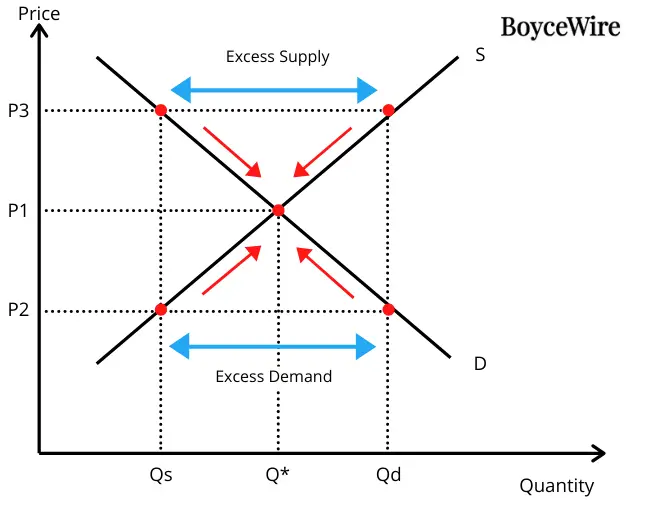The Invisible Hand: Definition, Pros, Cons & Example

What is the Invisible Hand
The invisible hand is a term that explains how the self-interest of the individual benefits the rest of society. In other words, by pursuing the profit motive, people must provide goods that others want, at a price they are willing to pay. In turn, society benefits as those goods might not otherwise have been produced.
The invisible hand itself was originally coined by Adam Smith in his book ‘The Wealth of Nations’, published in 1776. In his book, Smith uses the Invisible hand as a metaphor for the constant fluctuations that occur between supply and demand in order to reach equilibrium. These are forces that constantly push supply and demand back so that a socially optimal supply is reached.
To explain, when there is an oversupply of goods, prices fall so that demand increases. When there is an undersupply of goods, prices rise to encourage producers to increase production and supply. These two forces push the market towards the equilibrium point in what is known as ‘the invisible hand’.

As seen from the graph above, the invisible hand constantly pushes the market back into equilibrium. So at point P3, the market is in a state of excess supply. The high prices have driven producers to oversupply the market – driven by their own self-interest to make a profit.
The producers will be unable to sell all the goods at that price, so are forced to sell at a lower price otherwise make a 100 percent loss. This may mean they lose some money but would have gained from the higher prices. In turn, the market is brought back into equilibrium as consumers flock back at the lower price – at P1.
We then have the opposite effect whereby the price is low and there is a large amount of excess demand, which is shown as P2. Through the invisible hand, producers increase prices in order to capture excess consumer surplus. This is because there are more consumers than it is able to produce for, so it can charge higher prices. In turn this encourages suppliers to produce more. Supply then increases and demand falls to reach the equilibrium point.
Key Points
- The Invisible hand is a metaphor that refers to how individuals’ self-interests assist in bringing supply and demand to equilibrium.
- By pursuing ones self-interests, society benefits through the invisible hand.
- Critics claim that by pursuing their own self-interest, social economic inequalities widen rather than benefit society as the invisible hand suggests.
Invisible Hand Quote
Every individual… neither intends to promote the public interest, nor knows how much he is promoting it… he intends only his own security; and by directing that industry in such a manner as its produce may be of the greatest value, he intends only his own gain, and he is in this, as in many other cases, led by an invisible hand to promote an end which was no part of his intention.
The Wealth of Nations, Book IV, Chapter II, p. 456, para. 9.
Advantages of Invisible Hand
The invisible hand has been in action for centuries. It has brought billions of people together to work in their own interests and create goods and services for each other. Its success is clear to see through the advancement of the global economy throughout the last century and beyond.
Some of the main advantages of the invisible hand include:
1. Efficiency
Under the invisible hand, producers follow the profit motive, so there is an incentive to make production as efficient as possible. On the other hand, this may also encourage producers to cut corners in a bid to make more profit. Yet such businesses will not last long. After all, if the company doesn’t make a good or provide a service that the customer wants, it will go out of business.
If the firm reduces the quality to increase profit, the demand for such goods will adjust to the new quality. Any benefit to the firm will be short-lived. So over the long-term, there is an active incentive to not only to improve efficiency, but also maintain and improve quality.
2. Freedom
The invisible hand relies on the self-interest of each individual. However, this is based on the free choices of each person. It is not from the goodwill of the baker that he provides bread to his customers. Nor is the baker coerced into doing so. It is through the entrepreneurial nature of the baker that he identifies a gap in the market that needs to be fulfilled.
Those filling the gap in the market are doing so because they can see demand for such. At the same time, they are driven by their own self-interest to earn some profits. Yet without that self-interest, it is likely that nobody would exploit that gap in the market. After all, why go through the hardship of creating and delivering a new product to market?
3. Socially Optimal
The invisible hand allows supply and demand to fluctuate and draws the market to the equilibrium. This is seen as the socially optimal point because it avoids shortages as well as oversupply.
Through the invisible hand, supply increases in response to an increase in the price. This incentivises producers through their own self-interest to produce more of the demanded good. Similarly, when demand is low, they are incentivized to reduce prices in order to match supply with demand.
This is socially optimal because if prices are too low, we end up with a shortage in the market – meaning consumers have to ration and go without. Similarly, producers may overproduce, meaning they have to reduce prices to attract customers – thereby making an effective loss.
Limitations of the Invisible Hand
The main limitation of the invisible hand is that it assumes markets are efficient, and people are rational. For instance, price increases may not always lead to lower demand, especially when considering the price of alternative goods and the quality of the product. People do not always react in the way we would expect. This is because there are often multiple variables that people consider often in split seconds – ranging from price, convenience, to opportunity cost.
1. Negative Externalities
One of the main drawbacks of the invisible hand is that by pursuing their own self-interests, people and businesses can create external costs. Such examples include pollution or over-production such as over-fishing. This leads to costs to society which are not accounted for in the final cost of the goods.
2. Monopolies
Some industries such as utilities and trains are more prone to monopoly power as they can be considered natural monopolies. In such markets and many more, businesses can exert monopoly power and distort the supply and demand equilibrium – thereby invalidating the invisible hand. Quite simply, it is unable to function. As a result of limited competition, firms can become stagnant and inefficient, whilst increasing costs to customers.
3. Irrationality
The invisible hand doesn’t always work as efficiently as we would expect – especially in a number of industries. This is because humans can be emotionally charged and irrational at times. For example, financial markets are prone to irrational exuberance that leads to booms and busts in asset prices. If we look at the dot com boom towards the end of the 20th and into the 21st century, we can see how stockbrokers got caught in a wave of irrational optimism. They purchased technology stocks that were losing money but thought the rapid revenue growth would ensure profitability in the long-term.
4. Real-World Problems
The invisible hand works in theory and in a lot of markets, but it can also create individual problems. For example, if demand falls, it may cause people to lose their jobs. Without those jobs, people will have to live without that income for a period of time.
We would assume that under the invisible hand, people would move to where labour is needed. However, in reality, this is not always the case. People often stay in the local vicinity to where they grew up – especially near family. Labour forces tend to be quite immobile, as ‘liquid’ labour does not exist in the real world.
Invisible Hand Example
Perhaps one of the most iconic examples of the invisible hand is that which was used by Milton Friedman. In his demonstration, he uses the simple pencil as an example. The pencil is a quite simple instrument, yet not a single person in the world could make this by themselves.
The wood may be sourced from a tree in North America. To cut that tree down, the lumberjack requires a saw. In turn, that saw requires steel which is made through iron ore and coal – both of which need to be mined.
We then have the lead in the pencil – which is actually known as graphite. Again, this has to be mined – perhaps from a mine in South America. This then moves us onto the rubber of the pencil. It may be sourced from Malaya – where the rubber tree is not even native to the country. Instead, it was imported from South America under British rule.
There is also the brass feral which holds the rubber in – perhaps it came from Turkey or Syria which manufacture brass. We then finally have the paint that is used to finish the pencil.
Thousands of people have come together to make what is seen as a relatively simple product. They have given up their time in order to exchange it for that of the customers, in an exchange that works seamlessly – all due to the self-interest of each party.
The best part is that these people get together for the common good no matter what race, religion, or sex. Some of the individuals may not even like each other, yet the invisible hand brings this all together to create a final product.
FAQs on The Invisible Hand
The concept of the invisible hand is based on the premise that by individuals serving their own self-interest, society benefits through an ‘invisible hand’. This is because producers have to meet consumer demand if they want to stay profitable and they only do so if they satisfy the customer – at least in the long run.
If we look at a simple pencil – nobody in the world can make it by themselves. It requires someone to cut the wood down, another to mine iron ore and coal for the saw to cut the wood down, and another mine in South America to produce the graphite for the ‘lead’ in the pencil. Yet this is only half of it. There is also the issue of the rubber which is predominantly grown in Malaya – yet the rubber tree was imported into Malaya by the British. On top of that, we have the brass ring that hold the rubber in place and then finally the yellow paint or other finish. There are thousands of people coming together through their own self-interest via an ‘invisible hand’ that guides them.
The invisible hand benefits society as it leads to the most optimal production of a good. When there is a shortage of a good, prices rise, which allows producers to increase the supply of that good and meet demand. At the same time, when there is an oversupply, prices decline to attract consumers and increase demand.
About Paul
Paul Boyce is an economics editor with over 10 years experience in the industry. Currently working as a consultant within the financial services sector, Paul is the CEO and chief editor of BoyceWire. He has written publications for FEE, the Mises Institute, and many others.

Further Reading
 Binomial Distribution - The binomial distribution is a probability distribution that describes the number of successes in a fixed number of independent Bernoulli…
Binomial Distribution - The binomial distribution is a probability distribution that describes the number of successes in a fixed number of independent Bernoulli…  Accounting vs Economic Profit - The main difference between accounting and economic profit is that economic profit includes implicit costs. Whilst accounting profits include the…
Accounting vs Economic Profit - The main difference between accounting and economic profit is that economic profit includes implicit costs. Whilst accounting profits include the…  Central Limit Theorem - The central limit theorem states that as the sample size increases, the sampling distribution of the sample mean approaches a…
Central Limit Theorem - The central limit theorem states that as the sample size increases, the sampling distribution of the sample mean approaches a… 